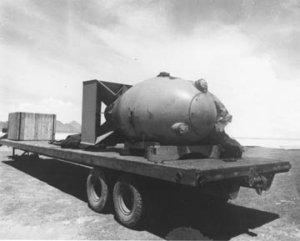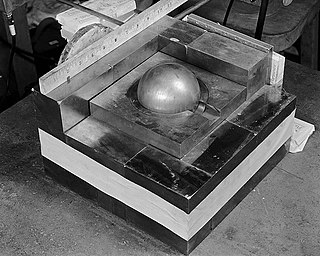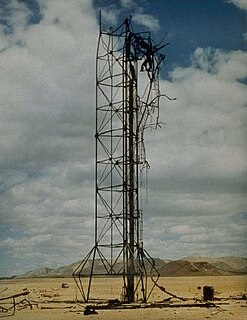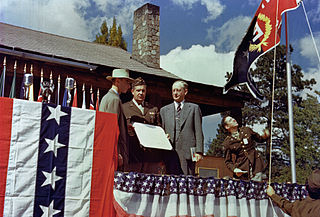
"Little Boy" was the codename for the type of atomic bomb dropped on the Japanese city of Hiroshima on 6 August 1945 during World War II. It was the first nuclear weapon used in warfare. The bomb was dropped by the Boeing B-29 Superfortress Enola Gay piloted by Colonel Paul W. Tibbets, Jr., commander of the 509th Composite Group of the United States Army Air Forces and Captain Robert A. Lewis. It exploded with an energy of approximately 15 kilotons of TNT (63 TJ) and caused widespread death and destruction throughout the city. The Hiroshima bombing was the second man-made nuclear explosion in history, after the Trinity nuclear test.

The Manhattan Project was a research and development undertaking during World War II that produced the first nuclear weapons. It was led by the United States with the support of the United Kingdom and Canada. From 1942 to 1946, the project was under the direction of Major General Leslie Groves of the U.S. Army Corps of Engineers. Nuclear physicist Robert Oppenheimer was the director of the Los Alamos Laboratory that designed the actual bombs. The Army component of the project was designated the Manhattan District as its first headquarters were in Manhattan; the placename gradually superseded the official codename, Development of Substitute Materials, for the entire project. Along the way, the project absorbed its earlier British counterpart, Tube Alloys. The Manhattan Project began modestly in 1939, but grew to employ more than 130,000 people and cost nearly US$2 billion. Over 90 percent of the cost was for building factories and to produce fissile material, with less than 10 percent for development and production of the weapons. Research and production took place at more than thirty sites across the United States, the United Kingdom, and Canada.

Los Alamos National Laboratory is a United States Department of Energy national laboratory initially organized during World War II for the design of nuclear weapons as part of the Manhattan Project. It is a short distance northwest of Santa Fe, New Mexico, in the southwestern United States.

Cyril Stanley Smith was a British metallurgist and historian of science. He is most famous for his work on the Manhattan Project where he was responsible for the production of fissionable metals. A graduate of the University of Birmingham and Massachusetts Institute of Technology (MIT), Smith worked for many years as a research metallurgist at the American Brass Company. During World War II he worked in the Chemical-Metallurgical Division of the Los Alamos Laboratory, where he purified, cast and shaped uranium-235 and plutonium, a metal hitherto available only in microgram amounts, and whose properties were largely unknown. After the war he served on the Atomic Energy Commission's influential General Advisory Committee, and the President's Science Advisory Committee.
Herbert James Sanborn, Jr. is an American sculptor. He is best known for creating the encrypted Kryptos sculpture at CIA headquarters in Langley, Virginia.

Louis Alexander Slotin was a Canadian physicist and chemist who took part in the Manhattan Project. Born and raised in the North End of Winnipeg, Manitoba, Slotin earned both his Bachelor of Science and Master of Science degrees from the University of Manitoba, before obtaining his doctorate in physical chemistry at King's College London in 1936. Afterwards, he joined the University of Chicago as a research associate to help design a cyclotron.

Haroutune Krikor Daghlian Jr. was an American physicist with the Manhattan Project, which designed and produced the atomic bombs that were used in World War II. He accidentally irradiated himself on August 21, 1945, during a critical mass experiment at the remote Omega Site of the Los Alamos Laboratory in New Mexico, and died 25 days later from the resultant radiation poisoning.

The Mark 6 nuclear bomb was an American nuclear bomb based on the earlier Mark 4 nuclear bomb and its predecessor, the Mark 3 Fat Man nuclear bomb design.

Pumpkin bombs were conventional aerial bombs developed by the Manhattan Project and used by the United States Army Air Forces against Japan during World War II. It was a close replication of the Fat Man plutonium bomb with the same ballistic and handling characteristics, but it used non-nuclear conventional high explosives. It was mainly used for testing and training purposes, which included combat missions flown with pumpkin bombs by the 509th Composite Group. The name "pumpkin bomb" was the term used in official documents from the large, fat ellipsoidal shape of the munition casing instead of the more usual cylindrical shape of other bombs, intended to enclose the Fat Man's spherical "physics package".

The National Museum of Nuclear Science & History is a national repository of nuclear science information chartered by the 102nd United States Congress under Public Law 102-190, and located in unincorporated Bernalillo County, New Mexico, with an Albuquerque postal address. It is adjacent to both the Albuquerque city limits and Kirtland Air Force Base.

The demon core was a spherical 6.2-kilogram (14 lb) subcritical mass of plutonium 89 millimetres (3.5 in) in diameter, manufactured during World War II by the United States nuclear weapon development effort, the Manhattan Project, as a fissile core for an early atomic bomb. The core was prepared for shipment as part of the third nuclear weapon to be used in Japan, but when Japan surrendered, the core was retained at Los Alamos for testing and potential later use. It was involved in two criticality accidents at the Los Alamos Laboratory on August 21, 1945, and May 21, 1946, each resulting in a fatality. Both experiments were designed to demonstrate how close the core was to criticality with a tamper, but in each case, the core was accidentally placed into a supercritical configuration. Physicists Harry Daghlian and Louis Slotin suffered Acute Radiation Syndrome (ARS) and died soon after, while others present in the lab were also exposed.

The uranium hydride bomb was a variant design of the atomic bomb first suggested by Robert Oppenheimer in 1939 and advocated and tested by Edward Teller. It used deuterium, an isotope of hydrogen, as a neutron moderator in a uranium-deuterium ceramic compact. Unlike all other fission-based weapon types, the concept relies on a chain reaction of slow nuclear fission. Bomb efficiency was adversely affected by the cooling of neutrons since the latter delays the reaction, as delineated by Rob Serber in his 1992 extension of the original Los Alamos Primer.
Terrestrial Physics is a sculpture by American artist Jim Sanborn which includes a full-scale working particle accelerator. It was displayed in the Museum of Contemporary Art as part of Denver's Biennial of the Americas from June–September 2010.

Yevgeniy Fiks is a multidisciplinary, Post-Soviet conceptual artist. His medium includes painting, drawing, performance, and book arts. He was born in Moscow, Union of Soviet Socialist Republics (USSR) in 1972 and has been living and working in New York City since 1994.
The RaLa Experiment, or RaLa, was a series of tests during and after the Manhattan Project designed to study the behavior of converging shock waves to achieve the spherical implosion necessary for compression of the plutonium pit of the nuclear weapon. The experiment used significant amounts of a short-lived radioisotope lanthanum-140, a potent source of gamma radiation; the RaLa is a contraction of Radioactive Lanthanum. The method was proposed by Robert Serber and developed by a team led by the Italian experimental physicist Bruno Rossi.

Nana on a Dolphin is a public artwork by French sculptor Niki de Saint Phalle. Nana on a Dolphin is part of the National Museum of Women in the Arts New York Avenue Sculpture Project and has also been on display at the home of Nicole Salinger in Provence, France.
Liz Larner is an American installation artist and sculptor living and working in Los Angeles.

The Los Alamos Laboratory, also known as Project Y, was a secret laboratory established by the Manhattan Project and operated by the University of California during World War II. Its mission was to design and build the first atomic bombs. Robert Oppenheimer was its first director, serving from 1943 to December 1945, when he was succeeded by Norris Bradbury. In order to enable scientists to freely discuss their work while preserving security, the laboratory was located in a remote part of New Mexico. The wartime laboratory occupied buildings that had once been part of the Los Alamos Ranch School.
Rozeal is a contemporary American artist known for her colourful and complex cross cultural painting technique. She best known for her narrative canvases commenting on cultural, racial and sexual identity. A large part of her work touches on the differences between appropriation and appreciation. Ultimately, Rozeals work and portrayal of pornographic prints illustrates a set of politically powerful messages.

John Coster-Mullen was an American industrial photographer, truck driver and nuclear archaeologist who played an important role in creating a public record of the design of the first atomic bombs. He is known for his critically-acclaimed self-published book Atom Bombs: The Top Secret, Inside Story of Little Boy and Fat Man.















